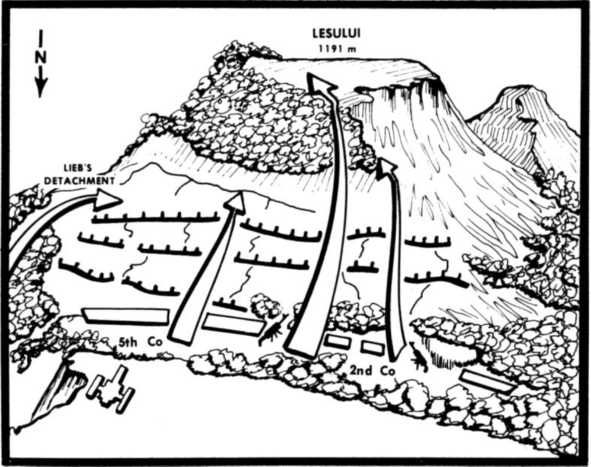In November, the Rumanians were prepared for a German thrust from Kronstadt in the direction of Bucharest and they had the bulk of their reserves concentrated in the area north of Ploesti. They were blissfully ignorant that General Kuhne was forming a new attack group in the Vulcan-Skurduk area for the purpose of forcing an entry into Wallachia and advancing on Bucharest from the west.
Early in November, units from our battalion, on the right of the new group, seized the line of heights running from Prislop through Cepilul to Gruba Mare. This operation was designed to provide protection for the debouchment of our main forces from the mountains. We had to fight hard and once we were in possession we worked hard to put our newly-won gains in condition to meet the inevitable counterattacks. The Rumanian fought well but all his counterattacks were beaten back and he began to wire himself in on the Stersura. On November 10, my company, less one platoon which was left behind on a security detail, was moved to Gruba Mare to participate in the attack of the Kuhne Group. The attack was scheduled for the eleventh and our Battalion mission was to seize the Lesului, a commanding peak some four thousand feet in elevation whose southern slopes formed part of the Wallachian frontier. The Rumanians had fortified this peak to the best of their ability and we could see several hostile positions located one behind the other in the saddle between Gruba Mare and Lesului. Our battalion mustered four and a half rifle companies (among them the 2nd). For this attack a mountain battery of artillery was attached in direct support. Gossler's detachment was to make a frontal attack while Lieb's was enveloping the hostile position from the east. Lieb had two and a half companies for his part of the job. The frontal attack was to jump off only after the enveloping force had been committed to action. (Sketch 15)
The 2nd Company was reinforced with a machine-gun platoon and dawn of November 11 found us on the right of the position a scant two hundred yards from the Rumanians. We were ready to go. On our way into the assembly area we ran into a Rumanian patrol and had a nice sharp fire fight which left us with a few prisoners and no losses. It also told the Rumanians that something unpleasant was afoot, and they spent the whole morning in combing the area with rifle and artillery fire. In this part of the world there was ample cover and we suffered no losses. We did not waste ammunition and reply to their fire, but we used our time in extending our reconnaissance of the enemy position and in drawing up, on the ground, complete plans for fire support during the attack. A mountain battery went into position to our left rear and numerous operations posts were established and put to good use. The hours passed by and it was noon before Lieb struck. At the first sounds we advanced with the other units of the Gossler detachment.
Before the 2nd Company advanced, Lieutenant Grau swept the hostile position with heavy machine-gun fire from his slightly elevated positions. Our men broke from cover and charged down the hill with the fury of a swollen torrent. The Rumanian decided not to wait; our charge swept him out of his trenches in the saddle, and in a few minutes we had reached the Lesului. Our prisoner bag was small, for the Rumanian showed marked ability in being able to slip from our clutches and disappear up one of the many ravines that dotted the saddle. However, our seizure of the Lesului summit was not long delayed and we bivouacked there for the night. The 2nd Company was pleased with itself for we had only one man wounded in this frontal attack.
After dark, reconnaissance detachments were sent south to locate the enemy and to search for food. Up to this time we had been liv-

Sketch 15
The situation at Lesului, November 11, 1916. V iew from the north.
Ing on extremely short rations. The detachments returned during the morning of the twelfth and reported that they were unable to make contact with the enemy. They brought in a variety of cattle and we got our cook fires going in a minimum of time. Food and the bright November sun made us forget the cold night in the tent.
Observations: The assembly area for the attack on November 11 was a reverse slope some two hundred yards from the enemy position. The enemy erred in not using combat outposts to prevent us from approaching to within so short a distance of his main battle position. The troops remained in this assembly area for several hours and were subject to harassing fire most of the time. The attack itself was supported by machine-gun fire delivered at two hundred yards range. The terrain was such that this was the only way of affording fire support.
The individual heavy machine guns first forced the enemy to take cover at those points where the assault platoons expected to break in. They kept up their fire while the troops covered the gap between positions and then they lifted and placed their fire on the rear positions of the hostile position. After a successful breakthrough, they followed quickly and supported the attack from improved positions in the elongated saddle. The enemy had been expecting an attack for several hours, but our mode of fighting was a total surprise to him.
We would have achieved an even greater success had we delayed the attack for thirty minutes. By that time Lieb’s outfit would have been in their rear instead of being merely on their flank.




 World History
World History









